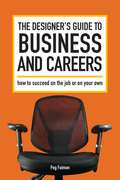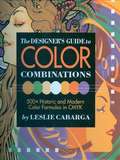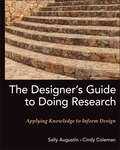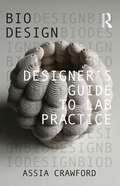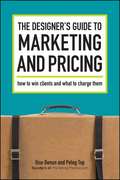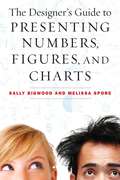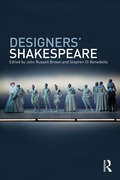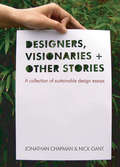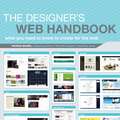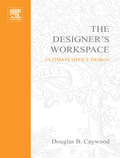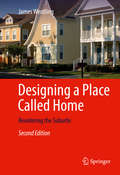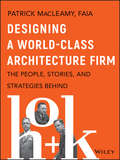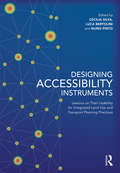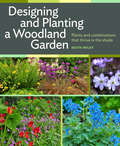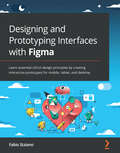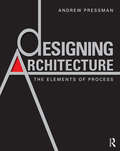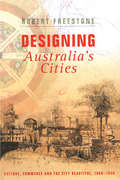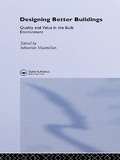- Table View
- List View
The Designer's Guide to Business and Careers
by Peg FaimonFind Your Niche and Be SuccessfulInside are the tools you need to get your design career off to a strong start–and maintain it for the long haul. Peg Faimon provides a comprehensive guide to basic business issues in today's competitive marketplace. Whether you just graduated from college, are building a freelance business, or are starting your own firm, this book will give you the confidence and knowledge to create a successful and fulfilling career. You'll learn how to:Research different career paths in design and organize your job searchCraft an effective portfolio and master interview techniquesMaintain a professional image and network to ensure a consistent stream of paying projectsCollaborate effectively with clients, other designers and experts in other professions (like printers, writers, marketers and executives)Establish a freelance business, develop your in-house career or kick start your own firmStay fresh and move forward in the ever-changing world of graphic designIn addition, real-world advice from working designers and an interactive format will help you apply your new skills right away. The Designer's Guide to Business and Careers will give you everything you need to experience immediate success in your career.
The Designer's Guide To Business And Careers
by Peg FaimonInside this comprehensive guide to basic business are the tools you need to get your design career off to a strong start-and maintain it for the long haul. From researching career paths, to crafting an effective portfolio, to ensuring a consistent stream of paying projects, here you'll find everything you need to experience immediate success in your career.
The Designer's Guide to Color Combinations
by Leslie CabargaIf you're from the "I don't know zip about color - but I know what I like" school of color theory, this book's for you. You won't find color wheels or lectures on color harmony here . . . just 500+ tried-and-true color combinations derived from actual design work - posters, packages, even giftware - created over the past century by designers, artists and color experts. You'll find historical color combinations from the Victorian period, Art Deco era, Far-out Sixties, Rave craze - plus current color combinations, such as limited color, "bad color" and much more. Even if you don't know what you're looking for, you'll know it when you see it here.It's not just what colors you use, but how you use them. That's why the color combinations in this book are arranged in simple, sample layouts rather than pages of out-of-context swatches. Complete with color formulas in CMYK, these layouts show you which colors work for backgrounds, borders, type, outlines, panels and small text, so you can easily adapt them to your designs.
The Designer's Guide to Color Combinations
by Leslie CabargaIf you're from the "I don't know zip about color - but I know what I like" school of color theory, this book's for you. You won't find color wheels or lectures on color harmony here . . . just 500+ tried-and-true color combinations derived from actual design work - posters, packages, even giftware - created over the past century by designers, artists and color experts. You'll find historical color combinations from the Victorian period, Art Deco era, Far-out Sixties, Rave craze - plus current color combinations, such as limited color, "bad color" and much more. Even if you don't know what you're looking for, you'll know it when you see it here.It's not just what colors you use, but how you use them. That's why the color combinations in this book are arranged in simple, sample layouts rather than pages of out-of-context swatches. Complete with color formulas in CMYK, these layouts show you which colors work for backgrounds, borders, type, outlines, panels and small text, so you can easily adapt them to your designs.
The Designer's Guide to Color Combinations
by Leslie CabargaIf you're from the "I don't know zip about color - but I know what I like" school of color theory, this book's for you. You won't find color wheels or lectures on color harmony here . . . just 500+ tried-and-true color combinations derived from actual design work - posters, packages, even giftware - created over the past century by designers, artists and color experts. You'll find historical color combinations from the Victorian period, Art Deco era, Far-out Sixties, Rave craze - plus current color combinations, such as limited color, "bad color" and much more. Even if you don't know what you're looking for, you'll know it when you see it here.It's not just what colors you use, but how you use them. That's why the color combinations in this book are arranged in simple, sample layouts rather than pages of out-of-context swatches. Complete with color formulas in CMYK, these layouts show you which colors work for backgrounds, borders, type, outlines, panels and small text, so you can easily adapt them to your designs.
The Designer's Guide to Doing Research
by Sally Augustin Cindy ColemanAn essential introduction to applying research for busy architects and designers The competitive design market and the need to create enduring value place high demands on architects and designers to expand their knowledge base to be able to digest and utilize multiple sources of information. Expected by their clients to be well versed on all aspects of a project, time-constrained architects and designers need quick responses in the face of daily challenges. As a result, these professionals must-more than ever-rely on, and apply, readily accessible information culled from sound research to gain a competitive advantage. The Designer's Guide to Doing Research serves as an introductory guide on the general concepts and processes that define "good" research. Organized logically with the practical tools necessary to obtain research for all facets of the designer's workflow, this book offers: Material written in an accessible format specifically for practitioners Reliable content by experienced authors-a noted environmental psychologist and an interior design educator who is also a practitionerand writer Tools for planning, executing, and utilizing research presented in an easy-to-follow format along with case studies, sources, and applications Written for all practices and people concerned with the built environment, from architects and interior designers to facility managers, landscape architects, and urban planners, this book serves as an invaluable starting point for gathering and implementing research effectively.
Designer’s Guide to Lab Practice (Bio Design)
by Assia CrawfordThis book explores the growing field of bio-design through interdisciplinary creative practice. The volume illustrates a range of experimental working techniques while offering a foundational understanding of lab practice principles. The book highlights the myriad of opportunities presented by microorganisms that have reshaped the planet and made it habitable. The book provides an account of the creation of living materials from the point of view of an architectural design practitioner. The transition from traditional design practice to laboratory investigation is captured, highlighting strategies of creating partnerships across a range of fields. The book demonstrates laboratory methods and ways of investigating the development of living materials and celebrates the growing body of practitioners, scientists, activists and anthropologists who are reimagining new strategies for addressing contemporary environmental challenges. Designer's Guide to Lab Practice looks at ways in which integrating living components with needs of their own would not only help offset the environmental impact that we have on our planet but could also create a closer relationship with nature. It is a working manual as well as a guide to emerging practitioners seeking to transition into a field that is yet to be defined and that offers the promise of a new era of human habitat making as a direct response to the looming ecological crisis.
The Designer's Guide To Marketing And Pricing: How To Win Clients And What To Charge Them
by Ilise BenunDo what you love and make money!The Designer's Guide to Marketing and Pricing will answer all the common questions asked by designers trying to stay afloat in their creative business - and also successful designers who want to put a little more thought into their operations. Whether you're a freelancer, an aspiring entrepreneur or a seasoned small-business owner, you'll learn everything you need to know about how to market and price your services.This book shows you how to:learn which marketing tools are most effective and how to use themcreate a smart marketing plan that reflects your financial goalsplan small actionable steps to take in reaching those financial goalsdetermine who your ideal clients are and establish contact with themturn that initial contact into a profitable relationship for both of youtalk to clients about money and the design process - without fearfigure out a fair hourly rate and give an accurate estimate for a projectYou'll learn the ins and outs of creating and running a creative services business - the things they never taught you in school. Plus, there are useful worksheets throughout the book, so you can apply the principles and formulas to your own circumstances and create a workable business plan right away.
The Designer's Guide To Marketing And Pricing
by Ilise Benun Peleg TopDo what you love and make money! The Designer's Guide to Marketing and Pricing will answer all the common questions asked by designers trying to stay afloat in their creative business - and also successful designers who want to put a little more thought into their operations. Whether you're a freelancer, an aspiring entrepreneur or a seasoned small-business owner, you'll learn everything you need to know about how to market and price your services. This book shows you how to:learn which marketing tools are most effective and how to use them create a smart marketing plan that reflects your financial goals plan small actionable steps to take in reaching those financial goals determine who your ideal clients are and establish contact with them turn that initial contact into a profitable relationship for both of you talk to clients about money and the design process - without fear figure out a fair hourly rate and give an accurate estimate for a project You'll learn the ins and outs of creating and running a creative services business - the things they never taught you in school. Plus, there are useful worksheets throughout the book, so you can apply the principles and formulas to your own circumstances and create a workable business plan right away.
The Designer's Guide to Marketing and Pricing
by Ilise Benun Peleg TopDo what you love and make money! The Designer's Guide to Marketing and Pricingwill answer all the common questions asked by designers trying to stay afloat in their creative business - and also successful designers who want to put a little more thought into their operations. Whether you're a freelancer, an aspiring entrepreneur or a seasoned small-business owner, you'll learn everything you need to know about how to market and price your services. This book shows you how to: learn which marketing tools are most effective and how to use them create a smart marketing plan that reflects your financial goals plan small actionable steps to take in reaching those financial goals determine who your ideal clients are and establish contact with them turn that initial contact into a profitable relationship for both of you talk to clients about money and the design process - without fear figure out a fair hourly rate and give an accurate estimate for a project You'll learn the ins and outs of creating and running a creative services business - the things they never taught you in school. Plus, there are useful worksheets throughout the book, so you can apply the principles and formulas to your own circumstances and create a workable business plan right away.
The Designer's Guide to Presenting Numbers, Figures, and Charts
by Sally Bigwood Melissa SporeNumbers can tell an exciting story. The trick is to know what story to tell and make it understandable. This compact, practical guide will show everyone who must design numeric data how to transform raw data into readable, relevant information.The Designer's Guide to Presenting Numbers, Figures, and Charts brings together the guidelines established over the last forty years for making effective presentations of figures, tables, and graphs. Included are the straightforward steps designers and other professionals can take to make their tables and charts the most meaningful. The authors define and discuss a range of graph types, from simple bar and pie charts to contemporary "data visualizations," offering explanations of the intended application of each. Readers will learn when to use a table, when to use a chart, which chart is best to use, and how to make all numeric presentations as comprehensible as possible. Specific topics include: Rounding numbersTable constructionChart designGuidance on numbers and page layout Color Reference and demonstration tablesPresenting figures in PowerPointOrdering numbers for decision-makingMultiple comparisonsGridsAnd more Communicating information effectively is an increasingly important skill in the digital age. People find numbers persuasive, and well-executed visual presentations of information will influence more people and even shorten meetings. Complete with a glossary and helpful exercises, this guide offers everything needed to create more-effective presentations.
Designers' Shakespeare
by John Russell Brown Stephen Di BenedettoTheatre Design involves everything seen on stage: not only scenery but costumes, wigs, makeup, properties, lighting, sound, even the shape and material of the stage itself. Designers’ Shakespeare presents and analyses the work of a half-dozen leading practitioners of this specialist art. By focusing specifically on their Shakespearean work, it also offers a fresh, exciting perspective on some of the best-known drama of all time. Shakespeare’s plays offer an unusual range of opportunities to designers. As they were written for a theatre which gave no opportunity for scenic support or embellishment, designers are freed from any compulsion to imitate original practices. This has resulted in the extraordinarily diverse range of works presented in this volume, which considers among others the work of Josef Svoboda, Karl-Ernst Herrmann, Ming Cho Lee, Alison Chitty, Robert Wilson, Societas Raffaello Sanzio, Filter Theatre, Catherine Zuber, John Bury , Christopher Morley, Ralph Koltai and Sean Kenny. Designers’ Shakespeare joins Actors’ Shakespeare and Directors’ Shakespeare as essential reading for lovers of Shakespeare from theatre-goers and students to directors and theatre designers.
Designers Visionaries and Other Stories: A Collection of Sustainable Design Essays
by Jonathan ChapmanDesigners, Visionaries and Other Stories unpacks the complex and crucial debates surrounding sustainable design to deliver a compelling manifesto for change, at a time of looming ecological crisis, mounting environmental legislation and limited progress. This is a book about sustainable design, by the leading sustainable design thinkers, for creative practitioners, professionals, students and academics. This challenging work provides the reader with a rich resource of future visions, critical propositions, creative ideas and design strategies for working towards a sustainable tomorrow, today. The authors boldly present alternative understandings of sustainable design, to curate a challenging, sometimes uncomfortable and always provocative, collection of essays by some of the worlds leading sustainable design thinkers. The result is an impacting and polemical anthology that reinvigorates the culture of critique that, in previous years, has empowered design with the qualities of social, environmental and economic revolution.
The Designer's Web Handbook: What You Need to Know to Create for the Web
by Patrick McneilMake the Web Work for YouYou know how to design. But you can increase your value as a designer in the marketplace by learning how to make that design function on the web. From informational sites to e-commerce portals to blogs to mobile apps, The Designer's Web Handbook helps any designer understand the full life cycle of a digital product: idea, design, production and maintenance.The best web designers create not only beautiful sites but also sites that function well--for both client and end user. Patrick McNeil, creator of the popular web design blog designmeltdown.com and author of the bestselling Web Designer's Idea Book, volumes 1 and 2, teaches you how to work with developers to build sites that balance aesthetics and usability, and to do it on time and on budget.
The Designer's Web Handbook: What You Need to Know to Create for the Web
by Patrick McneilMake the Web Work for YouYou know how to design. But you can increase your value as a designer in the marketplace by learning how to make that design function on the web. From informational sites to e-commerce portals to blogs to mobile apps, The Designer's Web Handbook helps any designer understand the full life cycle of a digital product: idea, design, production and maintenance.The best web designers create not only beautiful sites but also sites that function well--for both client and end user. Patrick McNeil, creator of the popular web design blog designmeltdown.com and author of the bestselling Web Designer's Idea Book, volumes 1 and 2, teaches you how to work with developers to build sites that balance aesthetics and usability, and to do it on time and on budget.
The Designer's Workspace
by Douglas CaywoodThe Designer's Workspace presents an extensive resource of distinguished firms' responses to the design of their own offices. Featuring everythingfrom technical detail to interior design, it illustrates what these designers see as the major considerations for modern workplace design. This book reveals design solutions, details, and concepts that have been explored and used by design firms from around the world. From the first impressions at the Reception area and Lobby, to the appeal and diverse uses of the meeting areas, to the functionality and sleekness of the Design Studioitself, it illustrates how the designer's office can be quite unique in style, function, and character whilst also varying from culture to culture. No two designers will produce the same atmosphere. With this objective, The Designer's Workspace showcases an array of designs from the traditional to the contemporary, from the historic renovation to the new office tower and serves as a portfolio of the varied responses and solutions found to the challenge of designing the modern office.
Designing: A Journey Through Time
by Jacques R. GiardDesigning: A Journey Through Time uses the metaphor of a journey to explore how designing as an ongoing human activity has evolved over time and place.
Designing a Place Called Home
by James WentlingThis insightful volume shares design ideas to help builders, planners and architects create mass-produced affordable housing that pushes suburban development in more sustainable, liveable directions. The author argues that improving the quality of design in our new homes and communities for greater resiliency, sustainability, and equality, we can achieve developments that feel more like personalized, individual homes. Through text, photographs and illustrations, the book reviews prototypical American housing design, then suggest ways to both learn from the past as well as adapt for new environmental imperatives, demographic changes and lifestyle needs. Written by a practicing architect with 25+ years of experience optimizing residential design, this pioneering approach to suburban building will inspire readers to view mass produced housing through a new, modern lens.
Designing a World-Class Architecture Firm: The People, Stories, and Strategies Behind HOK
by Patrick MacLeamyOffers architects and creative services professionals exclusive insights and strategies for success from the former CEO of HOK. Designing a World Class Architecture Firm: The People, Stories and Strategies Behind HOK tells the history of one of the largest design firms in the world and draws lessons from it that can help other architects, interior designers, urban planners and creative services professionals grow bigger or better. Former HOK CEO Patrick MacLeamy shares the revolutionary strategies HOK’s founders deployed to create a brand-new type of architecture firm. He pulls no punches, revealing the triple crisis that almost bankrupted HOK and describes how any firm can survive and thrive. Designing a World Class Architecture Firm tells the inside story of many of HOK’s most iconic buildings, including the National Air and Space Museum, Moscone Convention Center, Oriole Park at Camden Yards, the Houston Galleria and the reimagined LaGuardia Airport. Each chapter conveys lessons learned from HOK’s successes —and failures— including: The importance of diversifying to depression-and-recession-proof your firm The benefit of organizing your firm around specialized leaders and project types The difference between leading and managing your people The value of simple financial metrics to ensure your firm’s health and profitability The “run toward trouble” strategy which prevents problems from ballooning MacLeamy delivers his advice via inspirational stories such as how HOK survived when its home office in St. Louis went up in flames and humorous stories, like the time an HOK executive was mistaken for royalty on a trip to Saudi Arabia. In this tell-all guide, the driven architecture or design professional will find the tools needed to evolve or grow any firm.
Designing Accessibility Instruments: Lessons on Their Usability for Integrated Land Use and Transport Planning Practices
by Cecilia Silva Nuno Pinto Luca BertoliniThe integration of land use and transport planning is key to making cities sustainable and liveable. Accessibility can provide an effective framework for this integration. However, today there is a significant gap between the advances in scientific knowledge on accessibility and its effective application in planning practice. In order to close this gap, Designing Accessibility Instruments introduces a novel methodology for the joint assessment and development of accessibility instruments by researchers and practitioners. The book: provides a theoretical and professional analysis of the main concepts behind the definition, use and measurement of accessibility; undertakes a comprehensive inventory and critical analysis of accessibility instruments, focusing on the bottlenecks in their transposition to planning practice; introduces and applies a novel methodology for the assessment and improvement of the practical use and usefulness of accessibility instruments; presents six in-depth illustrative case study applications of the methodology, representing a range of cities with different geographical and institutional settings, and different levels of urban and transport planning integration. The book is supported by a companion website – www.accessibilityplanning.eu – which extrapolates its content to a broader scope and keeps it updated and valid with new iterations of the methodology and further advances on the initial and new case studies.
Designing and Planting a Woodland Garden: Plants and Combinations that Thrive in the Shade
by Keith WileyFrom the creator of "one of the most exciting and innovative gardens in Britain today" With their moss-covered stones, towering trees, and pockets of quiet shade, woodlands have a romantic power unlike anything else. Whether your garden is currently open and sunny, or on the small side, you can capture that sylvan atmosphere with carefully chosen trees and shade-loving plants. In Designing and Planting the Woodland Garden, Keith Wiley explains how to combine plants in natural, self-supporting colonies. His hand-picked selection of unexpected collectables—shrubs, perennials, bulbs, ferns, and grasses—mingle with garden favorites to create fabulous effects in all seasons.
Designing and Prototyping Interfaces with Figma: Learn essential UX/UI design principles by creating interactive prototypes for mobile, tablet, and desktop
by Fabio StaianoDiscover user experience and user interface design best practices while mastering a wide array of tools across Figma and FigJam with this full-color guideKey FeaturesLearn the basics of user experience research, result organization, and analysis in FigJamCreate mockups, interactive animations, and high-fidelity prototypes using this platform-independent web application toolCollaborate with a team in real-time and create, share, and test your designsBook DescriptionA driving force of the design tools market, Figma makes it easy to work with classic design features while enabling unique innovations and opening up real-time collaboration possibilities. It comes as no surprise that many designers decide to switch from other tools to Figma.In this book, you'll be challenged to design a user interface for a responsive mobile application having researched and understood user needs. You'll become well-versed with the process in a step-by-step manner by exploring the theory first and gradually moving on to practice. You'll begin your learning journey by covering the basics of user experience research with FigJam and the process of creating a complete design using Figma tools such as Components, Variants, Auto Layout, and much more. You'll also learn how to prototype your design and explore the potential of community resources such as templates and plugins.By the end of this Figma book, you'll have a solid understanding of the user interface workflow, managing essential Figma tools, and organizing your workflow.What you will learnExplore FigJam and how to use it to collect data in the research phaseWireframe the future interface with shape tools and vectorsDefine grids, typography, colors, and effect styles that can be reused in your workGet to grips with Auto Layout and the constraints to create complex layoutsCreate flexible components using styles and variantsMake your user interface interactive with prototyping and smart animateShare your work with others by exporting assets and preparing development resourcesDiscover templates and plugins from the communityWho this book is forThis book is for aspiring UX/UI designers who want to get started with Figma as well as established designers who want to migrate to Figma from other design tools. This guide will take you through the entire process of creating a full-fledged prototype for a responsive interface using all the tools and features that Figma has to offer. As a result, this Figma design book is suitable for both UX and UI designers, product and graphic designers, and anyone who wants to explore the complete design process from scratch.
Designing Architecture: The Elements of Process
by Andrew PressmanDesigning Architecture is an indispensable tool to assist both students and young architects in formulating an idea, transforming it into a building, and making effective design decisions. This book promotes integrative and critical thinking in the preliminary design of buildings to inspire creativity, innovation, and design excellence. This compendium of individual wisdom and collective experience offers explicit guidance to students and young professionals on how to approach, analyze, and execute specific tasks; develop and refine a process to facilitate the best possible design projects; and create meaningful architectural form. Here the design process – from orchestrating client participation to finalizing schematic design – is explored and illuminated. The following material is presented to make the book a useful didactic tool for professional development: explicit strategies for doing design rather than simply reviewing principles and precedents creative ideas in approaching and framing problems in design terms specific methods to translate ideas to culturally significant, socially responsive, and environmentally sensitive buildings techniques to integrate all levels of cognition from analysis to epiphany counsel on developing a personalized process for engaging design projects case studies augment the text and chronicle fascinating applications of the design process. The essence of this book lies in an integrated and holistic approach to each unique project as well as fostering curiosity and exploration – a departure from algorithms, easy generalities, or a formula for design. Designing Architecture will inspire readers to elevate the quality of preliminary designs and unravel some of the mystery of creating the most beautiful, responsive, and responsible architectural design possible.
Designing Australia's Cities: Culture, Commerce and the City Beautiful, 1900�1930 (Planning, History And Environment Ser.)
by Robert FreestoneAccessible and comprehensive, written by the current President of the International Planning History Society, this volume provides readers with a highly visual account of historical, contemporary and international projects.Looking at the ways in which the City Beautiful movement influenced the design and development of Australian cities, this pioneering national study surveys the ruling ideas, influences, outcomes and enduring legacies of the early artistic turn in Australian urban design. With the return of the American City Beautiful movement to the forefront of urban design, Designing Australia’s Cities is a relevant account of the ways in which this movement influenced and shaped Australian city design, but more importantly sheds light on a planning culture that stretches far beyond Australia and is of increasing relevance worldwide today.Laying bare an important design and reform movement, whose under-appreciated legacy is clearly evident in urban landscapes today, this book is ideal for students of planning, architecture, urban design and the history of planning.
Designing Better Building: Quality And Value In The Built Environment
by Sebastian MacmillanDesign is widely recognised as the key to improving the quality of the built environment. This well-illustrated book comprises 15 chapters written by leading practitioners, clients, academics and other experts, and presents the latest thinking on what design quality is and how to achieve it. For design practitioners and their clients alike, the book provides evidence to justify greater focus on, and investment in, design. It summarises the benefits that arise from good design - such as, civic pride in the urban environment, the stimulation of urban regeneration, corporate identity, occupant productivity and health in offices, improved learning outcomes in schools, better patient recovery rates in hospitals, as well as reduced environmental impact. And it illustrates these benefits through case study examples. Eight chapters focus on case studies of exemplary buildings in particular sectors - offices, schools, housing, and hospitals - and explain why and how they came to be designed, and the design qualities they exhibit.
